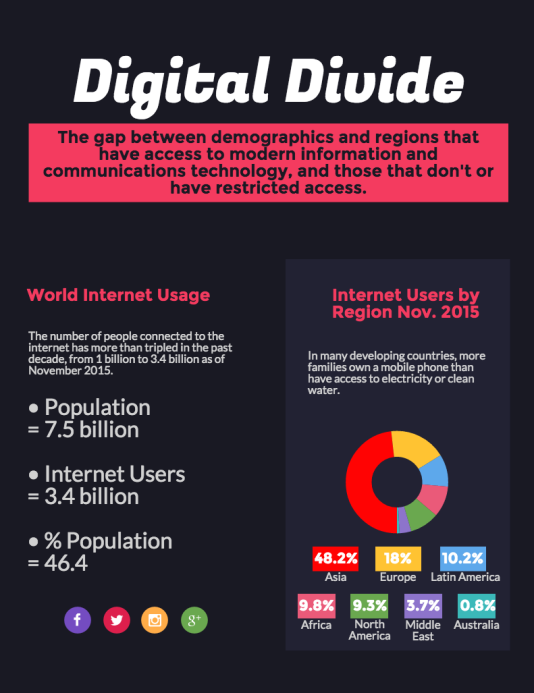
There are 3 main causes of the digital divide:
- That access to technology is unaffordable
- Individuals are unskilled and do not know how to use technology effectively
- And ‘Technophobia’, fear of technology and unawareness of the benefits
From the Piktochart we can see that a high proportion of Internet users are within Europe. A report from 2012 stated that high levels of competition have allowed the UK to enjoy the world’s cheapest broadband rates. Whilst in Mozambique, a study showed that it would cost the average citizen over two months’ wages to purchase just 1 gigabyte of data.
“We must continue to connect everyone and leave no one behind, because the cost of lost opportunities is enormous.”
Jim Yong Kim, the World Bank’s president.
There are many advantages to the Internet and specifically in using social media for education and business purposes, which the individuals with no access to the Internet will inevitably be deprived of.
Social media is such an effective way of networking, with so many different forms that can now connect people globally; these include Twitter, Facebook, Instagram and Blogging websites. With the digital divide, some countries are becoming less and less globally connected. Social media can be used for collaborative work on Facebook or for igniting debate and discussion on blog posts. The creation of pages on these social media platforms has also advantaged both education and businesses, whether for specific subjects and institutes or business marketing and job advertisements.
The main concern is how to bridge this digital divide!
With roughly 20% of the world’s population unable to read and write, an increase in digital access alone will not solve the digital divide. We need to improve the country’s business climate, invest in people’s education and health, and promote good governance.
This video, although created in 2011 making the figures out-dated, I believe really helps you understand the main reasons for the digital divide, the trends within these causes and how to bridge the divide. Moreover, Aleph Molinari has such an innovative and sustainable solution to help bridge the digital divide.
Additionally, there is a group of private and public sector organisations that have launched a coalition. The Alliance of Affordable Internet aims to persuade countries to change how they allocate spectrum and promote infrastructure-sharing efforts in order to force prices of the Internet down. Sponsors of this include Google, Facebook, Microsoft and the US State Department.
“The reason for the alliance is simple – the majority of the world’s people are still not online, usually because they can’t afford to be.”
Sir Tim Berners-Lee, founder of the World Wide Web Foundation.
References:
The Guardian (2016) Spread of internet has not conquered ‘digital divide’ between rich and poor
World Bank (2016) World Development Report 2016: Digital Dividends
BBC (2013) UK jumps up internet scoreboard as digital divide grows
Blogspot (2010) The Digital Divide
BBC Active (2016) How social media is changing education
Internet World Stats (2015) Internet Usage Statistics
TED (2011) Bridging the Digital Divide
It was great to read another blog post about the digital divide, the same topic that I chose.
Your piece I thought was very informed, highlighting a lot of the different aspects of the digital divide which can often be whittled down to only aiming for universal physical access.
The idea of cost preventing so many people from accessing the Internet is a baffling problem. When citizens are able to tap into the greatest human information system in the world they can be more informed and active participants of society. I like the alliance that has been set-up, which should hopefully get more people online!
LikeLike
Hi Alice,
This was such an interesting piece, especially as my post was based around the same sub topic of social media ethics. I like your use of many medias such as the piktochart and youtube video. I think it’s a great way to back up your arguments.
I completely agree with all of your arguments regarding the main reason for this digital divide.I have chosen to go the same direction with my own post on this topic. I think it is such a pressing issue in our world today, and I find it hard to wrap my head around how expensive getting online, something so minuscule for us, can be for certain areas of the world. But as you mentioned, efforts are being made to try to make it as easy for others to get online as it is for us.
Going back to the reasons for the digital divide, do you really think people have a fear of technology?
Keep up the good work!
LikeLike